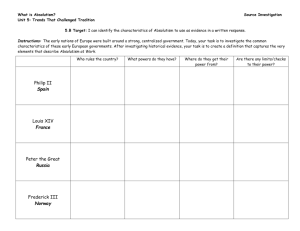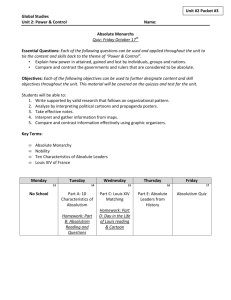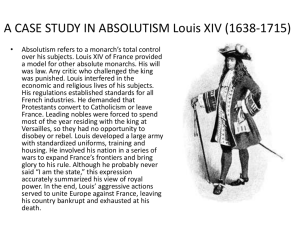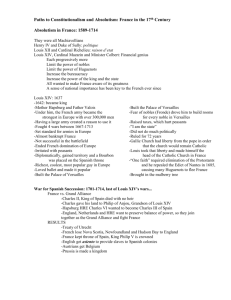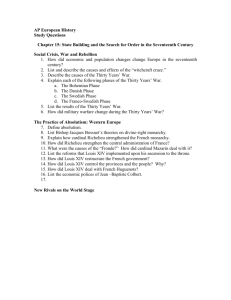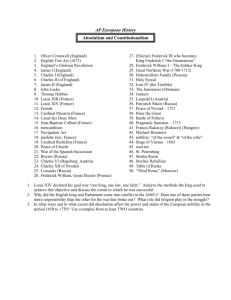Chapter 16 Part 1
advertisement
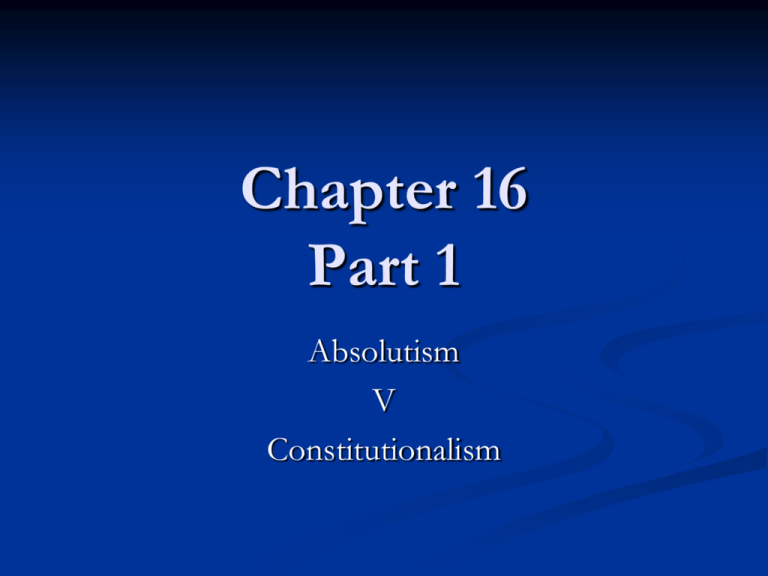
Chapter 16 Part 1 Absolutism V Constitutionalism Absolutism in Western Europe 1589-1715 Absolutism: the traditional assumption of power (heirs to the throne) and the belief in “divine right of kings” Louis XIV was the quintessential absolute monarch Characteristics of Western European Absolutism The Ruler of a country was sovereign The Ruler is not subordinate to national assemblies The nobility is under the control of the ruler Will be different in Eastern Europe Nobility could still put obstacles in the way Characteristics of Absolutism in Western Europe Bureaucracies in the 17th century were often composed of career officials who owed their appointments to the king and were loyal to the king Often upper middle class bourgeoisie (nobility of the robe) Control over the Church Maintained large standing armies No more reliance on nobles or mercenary troops Characteristics of Absolutism in Western Europe Use of secret police to weaken political opponents Those who did not overtly oppose the state were usually left alone In contrast to the totalitarian regimes of the 20th century which required active participation and enthusiastic support The difference? Financial, technological resources The Philosophy of Absolutism Jean Bodin: Believed that only absolutism could provide order and force obedience to the government His POV: the religious wars in France in the late 16th C. Was among the first to provide a philosophical basis for absolutism The Philosophy of Absolutism Thomas Hobbes wrote The Leviathan Had little faith in human nature People were naturally nasty and brutish Without strong government control and micromanagement chaos would result Did NOT believe in “Divine Right” But too authoritarian for constitutionalists Philosophy of Absolutism Bishop Jacques Bossuet: BIG advocate of divine right Since the king was placed on the throne by God, he owed nothing to anyone else. Was a favorite of Louis XIV French Absolutism 1589-1648 In the 17th Century: Population of 17 million = 20% of Europe’s population Largest country in Europe Huge #’s helped make France the strongest European nation (bigger armies possible) 17th Century French Society Divided into 3 estates based on rank and privilege First Estate: The Clergy = 1% of the population Second Estate: The Nobility = 3-4 % of pop Third Estate: Everybody else from the Bourgeoisie to the landless peasants Taxes The Clergy and Nobility did not pay taxes The peasants and urban workers had little money The Bourgeoisie supported the whole country Henry IV 1589-1610 Established the Bourbon Dynasty after surviving the War of the Three Henrys Was a Politique: converted to Catholicism to gain popular support But issued the Edict of Nantes: religious freedom for Huguenots and gave them the right to live in fortified cities Henry IV Laid the foundation for France to become the strongest European power in the 17th Century Strengthened the social hierarchy by strengthening existing institutions: Parlements, the Treasury, Universities and the Catholic Church Henry IV The First French King to take an interest in France colonizing in the New World Encouraged trans-Atlantic trade Henry IV Weakened the Nobility of the Sword They were not allowed to influence the Royal Council Many of the Nobility of the Robe (who had purchased their titles) became high government officials and were intensely loyal to the monarch The Duke of Sully: French Finance Minister His reforms enhanced the power of the monarchy Mercantilism: increased the role of the state in the country’s economy to achieve a favorable balance of trade with other countries Granted monopolies in the production of gunpowder and salt Sully and Mercantilism Encouraged the silk industry, tapestry industry Only the government could operate the mines Reduced the Royal debt With systematic bookkeeping and budgets Reformed the tax system (more equitable) Improved transportation: roads, bridges, canals Even began to build a canal linking the Mediterranean to the Atlantic! In the Meantime… Spain was drowning in debt Henry IV was assassinated in 1610 By a fanatical monk who was upset with the Edict of Nantes Henry’s death = a crisis in power Henry’s widow (now Marie de Medici) ruled as regent until their son came of age Louis XIII 1610-1643 His regency was a mess Feudal nobles and princes increased their power Some increased their influence at court Some convinced Louis XIII to exile his own mother and assume power for himself Cardinal Richelieu 1585-1642 Laid the foundation for absolutism in France Richelieu –in spite of being a cardinal- was also a politique…put the state ahead of religious matters Richeleau introduced the Intendant System The Intendant System Was used to weaken the Nobility (Sword) Replaced local officials with intendants (civil servants) who reported directly to the king Were generally middle class (of the robe) One Intendant per each of France’s 32 districts Intendants were responsible for policing, finance and justice in his district Intendants were NEVER placed near their hometowns Government was more efficient and centralized Richelieu also continued with Mercantilism Built on Sully’s achievements Increased taxes to fund the military But new tax system not as successful as Sully’s Continued to sell government offices Farmers and peasants were ruthlessly exploited Richelieu and the Huguenots Tweaked the Edict of Nantes with The Peace of Alais (1629): Huguenots were still able to practice their religion freely BUT No more fortified cities and Protestant armies The Thirty Years’ War France supported Gustavus Adolphus in the 3rd phase of the war France declared war on the Spanish in 1635 (ended in 1659 with the Treaty of the Pyrenees) and also entered the Thirty Years’ War against the HRE’s Hapsburg army (Westphalia in 1648) Kept to the same foreign policy of keeping Germany divided Louis XIV 1643-1715 The Sun King because he was the center of French power just as the sun is the center of the solar system Personified the idea that the sovereignty of the state resides in the ruler “L’ e’tat, c’est moi” “I am the state” Louis XIV Was a strong believer in Divine Right Had the longest reign in European History (72 years) Inherited the throne at age 5 France was the major power in Europe during his reign…largest pop = largest army French culture dominated Europe French became the international language for over two centuries and the language of the welleducated Was the epicenter of literature and the arts until the 20th century The Fronde (1640’s) Cardinal Mazarin controlled France while Louis XIV was a child Some of the nobles (of the Sword) revolted against Mazarin when Louis was between 5 and 14 years Mazarin was able to defeat the nobles due to the competition among themselves Louis never forgot the humiliation and will keep a close watch on the nobility throughout his reign The Government under Louis XIV Kept the aristocracy out of the government by recruiting his closest ministers from the middle class Curtailed the powers of institutions that could pose a danger to the throne (the Parlements were afraid to cross him) Louis XIV never called the Estates General together Would arrest officials who were critical of the government Control of the Peasants Peasants about 95% of the population Kept only about 20% of their incomes after tithes to the Church, government taxes, and feudal rents. The Corvee caused more hardship: forced labor. Required peasants to give one month’s labor a year to the crown (road building, etc) Idle peasants conscripted into the army Rebellious peasants were executed or used as galley slaves Versailles Was the grandest and most impressive palace in all of Europe Baroque: reinforced the image of Louis XIV as the most powerful absolute ruler in Europe Was originally a hunting lodge for Louis XIII Architecture of the palace: Marquis Louvois The Gardens: LeVau The royal court = 600 people Cost of maintenance = 60% of all royal revenue Versailles Became a pleasure prison for the French nobility Louis required nobles to live at Versailles several months a year so he could keep an eye on them Nobles were entertained: many hunts, tournaments and concerts Elaborate theatrical productions by Racine (tragedies) and Moliere (comedies) Religious policies of Louis XIV Louis XIV considered himself the head of the Galician Church He WAS very religious but would not allow the Pope to exercise political power when it came to the French Church The Edict of Fontainebleau When Colbert died: Louis XIV revoked the Edict of Nantes 200,000 Huguenots fled to the New World, England, the Netherlands Colbert was the champion of mercantilism…was a finance minister Also Louis XIV supported the Jesuits when they wanted to crack down on the Jansenists Jansenists were Catholics who held some Calvinist ideas


